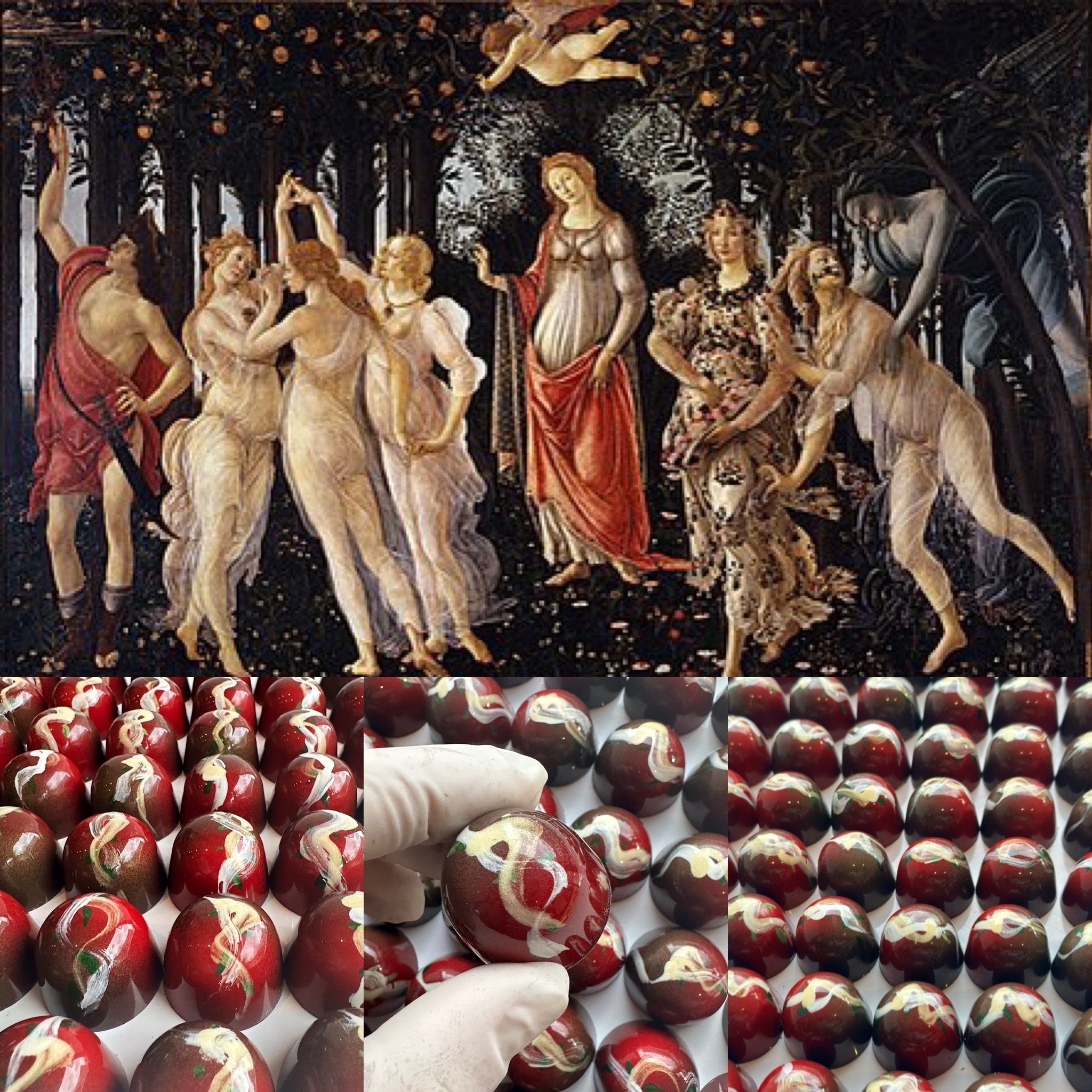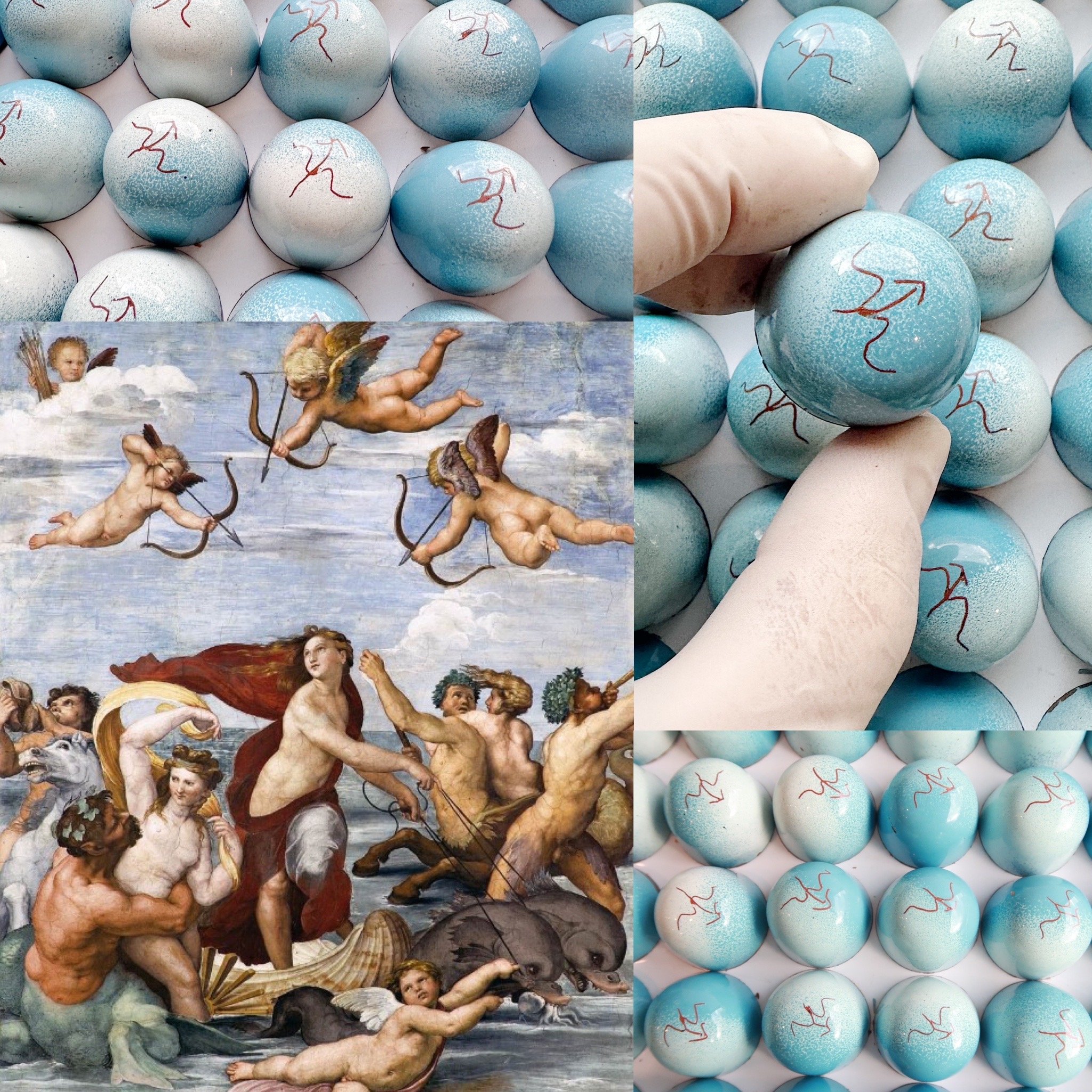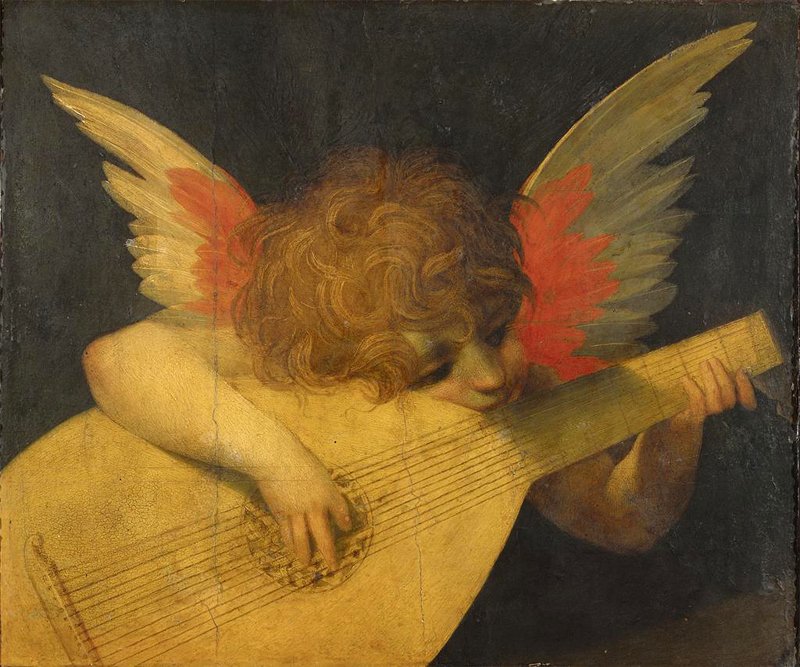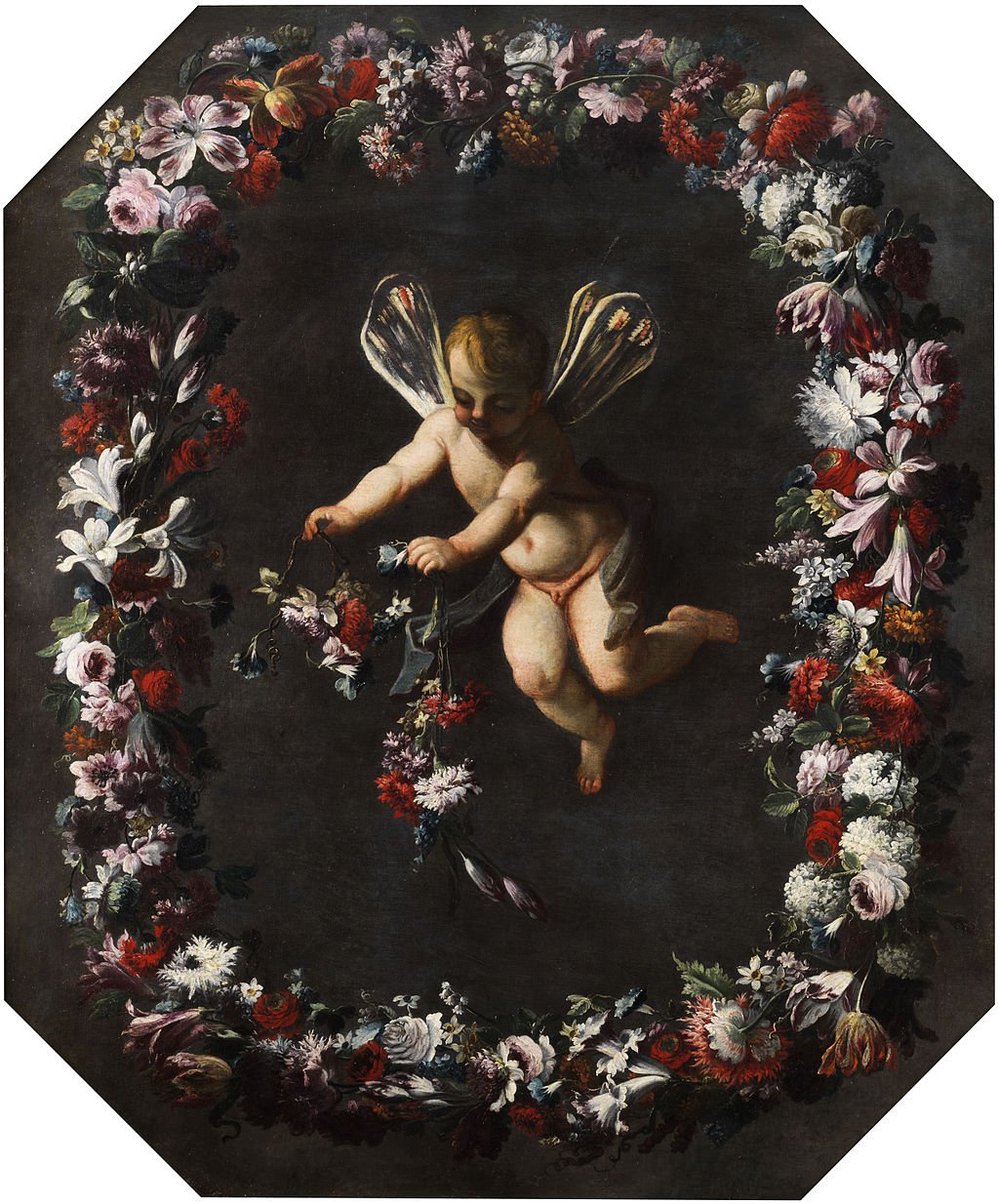Our Tiramisu bonbon. Filled with a coffee caramel, marsala and mascarpone ganache, and a ladyfinger almond praline.
“Primavera”, Sandro Botticelli, 1470’s
Primavera (Italian pronunciation: [primaˈvɛːra], meaning "Spring"), is a large panel in tempera paint by Sandro Botticelli, made in the late 1470s or early 1480s (datings vary). It has been described as "one of the most written about, and most controversial paintings in the world, and also one of the most popular paintings in Western art.
The painting depicts a group of figures from classical mythology in a garden, but no story has been found that brings this particular group together. Most critics agree that the painting is an allegory based on the lush growth of Spring, but accounts of any precise meaning vary, though many involve the Renaissance Neoplatonism which then fascinated intellectual circles in Florence. The subject was first described as Primavera by the art historian Giorgio Vasari who saw it at Villa Castello, just outside Florence, by 1550.
For more information, click here.
Our Raphael bonbon is filled with a candied herb “cloud”, and a tart mandarine ganache.
Triumph of Galatea, c.1512, by Raffaello Sanzio da Urbino (Raphael)
Raphael’s Triumph of Galatea, a fresco created around 1512 for the Villa Farnesina in Rome, depicts a scene later in the Nereid’s life, when Galatea stands triumphant in a shell chariot pulled along by dolphins. To the left, a Triton, half-man and half-fish, abducts a sea nymph, while another sounds a shell trumpet. The work is inspired by La Giostra (‘the Carousel’), a work by the poet Poliziano, who was tutor to the Medici, the ruling family of Florence, and one of the great pan European intellectuals of the age. He had begun to write La Giostra in honour of Giuliano de’ Medici’s victory in a tournament in 1475. He abandoned it three years later, following the conspiracy by the Pazzi family, which attempted to oust the Medici as rulers of Florence, during which Giuliano was stabbed to death during High Mass in the city’s Duomo. Poliziano saved the life of Giuliano’s brother, Lorenzo, by locking him in the Cathedral’s sacristy.
Raphael’s fresco was commissioned for the Villa Farnesina by Agostino Chigi, a hugely wealthy Sienese banker, who was treasurer to Pope Julius II. He had the villa built in Rome’s Trastevere area by Baldassarre Peruzzi between 1506 and 1510. It was acquired in 1577 by the Farnese family, whose members included Pope Paul III and Elisabeth Farnese, who became Queen of Spain in the early 18th century. The building, whose principal attraction remains Raphael’s fresco, is open to the public.
For more information: click here.
This bonbon representing a section of the ceiling of The Sistine Chapel is filled with a Limoncello from Campagna, a milk chocolate and honey ganache, and a Pizelle and Pignoli Praline.
This painting is a fresco which resides on the ceiling of The Sistine Chapel, painted by Michelangelo.
The construction of the building was carried out between 1473-1481 during the mandate of Pope Sixtus IV, to whom it owes its current name. The architect responsible for the construction was Giovanni of Dolci.
The most striking thing about the Sistine Chapel is not its architecture, but the frescoes that completely cover the walls and the ceiling. While there are other well known Renaissance artists who painted the frescos, some of the most well known and recognized are that of Michelangelo, who was commissioned for the ceiling program of the chapel by Pope Julius II. Prior to the Sistine Chapel, Michelangelo primarily worked as a sculptor, (also responsible for sculpting the statue of David).
Originally seen as the “underdog” of the Vatican painters, (as he was not known for his work with the brush), he may be the most recognized artists of the period, (and of any period). Michelangelo emerged as one of the most influential and famous Renaissance painters.
This “Birth of Venus” bonbon is filled with our classic and favorite- Salted Caramel.
“Birth of Venus” Sandro Botticelli (Firenze 1445 – 1510)
Known as the “Birth of Venus”, the composition actually shows the goddess of love and beauty arriving on land, on the island of Cyprus, born of the sea spray and blown there by the winds, Zephyr and, perhaps, Aura. The goddess is standing on a giant scallop shell, as pure and as perfect as a pearl. She is met by a young woman, who is sometimes identified as one of the Graces or as the Hora of spring, and who holds out a cloak covered in flowers. Even the roses, blown in by the wind are a reminder of spring. The subject of the painting, which celebrates Venus as symbol of love and beauty, was perhaps suggested by the poet Agnolo Poliziano.
It is highly probable that the work was commissioned by a member of the Medici family, although there is nothing written about the painting before 1550, when Giorgio Vasari describes it in the Medici’s Villa of Castello, owned by the cadet branch of the Medici family since the mid-15th century. This hypothesis would seem to be born out by the orange trees in the painting, which are considered an emblem of the Medici dynasty, on account of the assonance between the family name and the name of the orange tree, which at the time was ‘mala medica’.
Unlike the “Allegory of Spring”, which is painted on wood, the “Birth of Venus” was painted on canvas, a support that was widely used throughout the 15th century for decorative works destined to noble houses.
Botticelli takes his inspiration from classical statues for Venus’ modest pose, as she covers her nakedness with long, blond hair, which has reflections of light from the fact that it has been gilded; even the Winds, the pair flying in one another’s embrace, is based on an ancient work, a gem from the Hellenistic period, owned by Lorenzo the Magnificent.
For more information: click here.
This “Birth of Venus” bonbon is filled with our classic and favorite- Salted Caramel.
Cherub Playing a Lute or Musical Cherub,1521, Rosso Fiorentino
This famous work, featuring a child angel plucking the strings of a lute, is a fragment of a lost altarpiece; underneath the dark background, added retrospectively, reflectographic studies have revealed part of a building, at the base of which the musical angel would have stood in the manner of certain compositions by Fra’ Bartolomeo or Raphael. The original composition can be inferred from the Sacred Conversation painted in around 1600 by Francesco Vanni and housed in the church of Sant’Agata ad Asciano in Siena.
Underneath the dark background of this painting in the Uffizi, reflectographic studies have also revealed the name of the artist, Rosso Fiorentino, and the date 1521, but it is not certain whether the handwriting is Rosso's own or if it was added when the altarpiece was dismantled in an effort to preserve the knowledge of its authorship.
Portraying the very tender image of the child angel apparently unconfident in his effort to handle the lute so overly large by comparison, this painting is Rosso Fiorentino's original reinterpretation of a traditional theme where the notably modern brushstrokes give the work a particularly vivid effect.
For more information: click here.
This “Birth of Venus” bonbon is filled with our classic and favorite- Salted Caramel.
Giovanni Stanchi dei Fiori (1608-ca1673) — Putti with dragonfly wings in a flower garland,1673
The painting is an exquisite and very representative example of Giovanni Stanchi's work. Stanchi came from an established family of artists in Rome. The oldest known documentation about him is from the year 1634, when his name is mentioned in the register of the Accademia di San Luca. In 1638 he was commissioned to paint the family coat of arms of the Barberini family, surrounded by a wreath of flowers. It was the beginning of a series of orders from prominent art patrons in Rome, including Cardinal Flavio Chigi, who is said to have owned fourteen works by Stanchi; Benedetto Pamphili, who commissioned eighteen works; and Cardinal Mario Albrizi, who owned nine of his paintings. A large number of works by Stanchi were also included in the significant collections of the Colonna and Barberini families. Even the Medici family was said to be fond of Stanchi's style.
Stanchi also enjoyed success as a painter of decortive schemes. Examples of palace interiors decorated by him and his studio staff are the Chigi family's palace in Ariccia, the Palazzo Pitti in Florence and the Doria-Pamphili palace on Via del Corso in Rome. Stanchi's work shows some similarities with Flemish still life painting, but there is also a clear fascination for light effects. The compatriot and predecessor Caravaggio with his characteristic chiaroscuro - dim light - has probably not left him unaffected. Over time, however, he developed a very personal style, which gave him the nickname "Stanchi dei Fiori" - the flower stanchi.
For more information: click here.

















